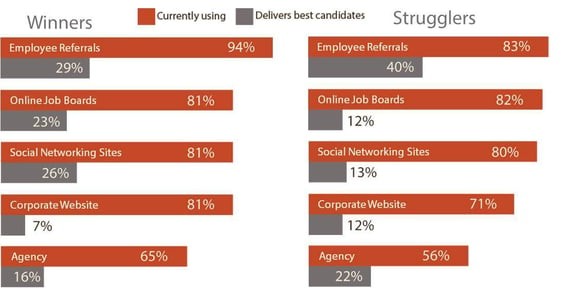 More and more signs are pointing towards the onset of a candidate’s market. The Conference Board in the US has been so bold as to predict a 15-year period of tight labor conditions.
More and more signs are pointing towards the onset of a candidate’s market. The Conference Board in the US has been so bold as to predict a 15-year period of tight labor conditions.
As the war for talent heats up, the results from our 2015 McQuaig Global Talent Recruitment Survey show some distinct differences in activity between those winning the war and those who are struggling.
Often the market is the predominant driver of whether companies are having a harder or easier time finding good candidates, but there are always some things companies can do to improve their results, and maybe even buck the overall trend.
First, let’s look at how the channels these two groups are using differ; in the survey report we call them Winners and Strugglers.

The Winners are much more likely to be using employee referrals as a formal channel and slightly more likely to be using agencies. When we look at which channels are providing the highest quality of candidates, though, the differences get interesting.
“94% of companies finding it easier to #recruit are using employee referrals as a channel” – Tweet This!
The Winners are realizing fairly even results across three channels (employee referrals, online job boards, and social networking sites), while the Strugglers are heavily reliant on employee referrals for quality candidates and then looking at external agencies as their next best bet.
Keep in mind, these are figures for where the best candidates come from, not necessarily the most. For that reason, spreading those results across more channels could be a hint as to why one group is more successful. If they’re pulling quality candidates from some of the more high-volume channels it stands to reason that the overall volume of quality candidates will be higher.
Recruiting strategies being employed to combat the talent shortage

The Winners are much more likely to be investing in training existing staff (75%). This could be a sign that they’re seeing a return on that investment and perhaps others should consider upping the investment in their existing workforce to compete.
“Successful companies more likely to invest in training existing staff to combat talent shortages” – Tweet This
They’re also more likely to be offering flexible work arrangements and tweaking job definitions than their counterparts.
This is just a taste of what the responses of more than 450 HR professionals told us. You can get the full story by downloading the complete report.
Download the complete survey report here.